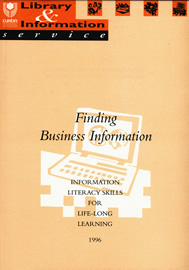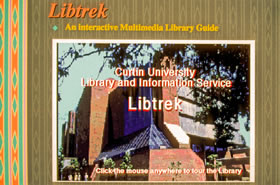
Library education (Information literacy) programs
Throughout the 1990s, classes 19, tours and a growing range of self-paced and self-guided resources 20 were offered to assist clients to make the best use of the Library’s resources. A particular focus was helping clients to use the ever-increasing electronic information sources, including CD based and online journal indexing databases, the online catalogue (CLUE and its successors), and the Internet.
In 1992, the Library added self-paced mini tutorials and quick reference guides about each journal indexing database to the mix of resources offered, as well as conducting face-to-face classes covering the basics of searching within and retrieving information from electronic sources. Over 8 500 students participated in some form of library education program (self-paced or face-to-face) that year.
The Library reviewed its reader education program in 1993 and one of the outcomes was a change of name – to the information literacy program. Another was the recognition that Library staff needed to be knowledgeable about the Internet and skilled in the tasks of acquisition, organization and presentation of electronic information sources. The provision of more training, often in-house by other staff, was an important consequence. In June 1995, for example, staff were introduced to the mysteries of home pages, html and urls, etc. by other Library staff in the level three training room.
In the rapidly changing environment of electronic information, the demand for information literacy classes continued to rise with growing impact on the limited number of Library staff. By 1996 Curtin’s student numbers had roughly tripled from 1986 levels, rising to almost 23 000, while staff numbers had increased to over 2 400.
The Library was already moving to replace face-to-face library education classes embedded in the course content for first year undergraduate students with self-directed learning packages. These efforts intensified and a major success was the inclusion in 1996 and 1997 of self-guided information literacy packages in first year units studied by all undergraduate students in business and health sciences.
In 1996, the Library secured University funding to produce information literacy units for postgraduate students.
Tailored workshops were still offered for second and third year units on request while sign up database and web sessions were offered to all. To mirror the content of these sessions and ensure equality of access for external students, web based step-by-step guides to searching Curtin’s catalogue and some of the major databases were also created.
On campus, student assessment via multiple-choice tests on the content of library education guides was offered in the Computer Managed Learning Laboratory in the Library.
In an environment where universities were recognizing information literacy as an increasingly important part of flexible and lifelong learning, an external review of the Library’s Information and Education Services unit was completed in May 1999. The review recommended that the Library move to place greater emphasis on flexible learning, including revamping its web presence and developing online generic information literacy resources.
Curtin adopts an information literacy policy
The Library proactively initiated, investigated and developed a University wide policy to support the development of information literate graduates. In July 1999 the University adopted an Information Literacy Policy, requiring information literacy to be included (and assessed) in all courses. A key role for the Library was to develop programs and materials to help course coordinators to meet this need.
InfoTrekk - a web-based information literacy package
With a strategic focus on flexible delivery and self-directed learning, the Library began developing a suite of web-based products to assist Curtin students to become information literate. In November 1999, it launched InfoTrekk, a generic information literacy program of ten short, user friendly ‘treks’ that covered topics such as ‘Understanding your reading list’, ‘Finding journal articles’, and ‘Evaluating resources’. 21 InfoTrekk covered the principles and processes of finding information but was not Curtin specific. It included multiple choice quizzes and useful links to catalogues and information guides.
In 2000, InfoTrekk was a required part of many first year courses and, by the following year, it was included in almost all such courses. It replaced most existing subject based workbooks and self-paced guides and was included in a ‘Start Up’ 22 CD the University provided to all incoming students.
The generic nature of the package meant significant savings in Library staff time as the number of resources needing to be constantly updated was reduced. Although a limited number of web-based subject guides were developed, these covered broad discipline areas.
 Cover of Finding business information: Information literacy skills for lifelong learning, 1996.
Cover of Finding business information: Information literacy skills for lifelong learning, 1996.
View a page from the booklet.
s.jpg) The loans desk on level two, early 1990s.
The loans desk on level two, early 1990s.
Note the 'SPI Stop No 12' sign on the pillar. Students using self-paced introduction to the Library booklets stopped to answer particular questions at SPI stop points throughout the building.
 Introductory screenshot for LibTrek, 1994.
Introductory screenshot for LibTrek, 1994.
In 1994, Library staff developed a different type of self-guided tour branded LibTrek. This interactive guide used hypertext links to allow users to move from screen to screen as they explored Robertson Library’s facilities and services.
It was mounted on a terminal just inside the Library entrance and was popular with users.
 Screenshot from LibTrek showing the location of services and collections on level three, 1994.
Screenshot from LibTrek showing the location of services and collections on level three, 1994.
InfoTrekk was well received across the University and was chosen as the Curtin nomination in the institutional category for the Australian Awards for University Teaching in 2001. InfoTrekk Plus, which provided an advanced information literacy package for postgraduate students and other researchers, was the next to be developed and was available on the Library’s website in 2002.